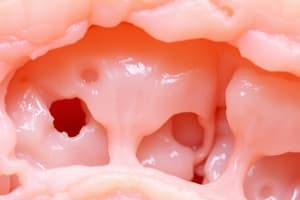Podcast
Questions and Answers
What is the primary characteristic of dysplasia in cellular growth?
What is the primary characteristic of dysplasia in cellular growth?
- It refers to disordered cellular growth. (correct)
- It leads to irreversible changes in all cases.
- It is a disorder that only occurs in cancer cells.
- It results in increased cell size.
Which condition is associated with the concept of metaplasia?
Which condition is associated with the concept of metaplasia?
- Cervical intraepithelial neoplasia.
- Myositis ossificans after trauma. (correct)
- Endometrial hyperplasia.
- Streak ovary in Turner syndrome.
What distinguishes aplasia from hypoplasia?
What distinguishes aplasia from hypoplasia?
- Hypoplasia results in normal organ size.
- Aplasia involves a complete absence of cell production. (correct)
- Aplasia leads to larger organ size.
- Hypoplasia is associated with tumor formation.
What happens to dysplasia if the inciting stress is not alleviated?
What happens to dysplasia if the inciting stress is not alleviated?
Which of the following best defines hyperplasia?
Which of the following best defines hyperplasia?
Which of the following statements accurately describes hypertrophy?
Which of the following statements accurately describes hypertrophy?
What is the primary mechanism through which atrophy occurs?
What is the primary mechanism through which atrophy occurs?
Which of the following statements about hyperplasia is true?
Which of the following statements about hyperplasia is true?
In which situation would metaplasia typically occur?
In which situation would metaplasia typically occur?
Which of the following is a characteristic of benign prostatic hyperplasia (BPH)?
Which of the following is a characteristic of benign prostatic hyperplasia (BPH)?
What role does vitamin A play in epithelial differentiation?
What role does vitamin A play in epithelial differentiation?
What does Barrett esophagus exemplify in terms of cellular adaptation?
What does Barrett esophagus exemplify in terms of cellular adaptation?
Which cellular process involves the tagging of cytoskeletal components for degradation?
Which cellular process involves the tagging of cytoskeletal components for degradation?
Study Notes
Hyperplasia and Hypertrophy
- Increase in stress leads to increased organ size.
- Occurs through increased cell size (hypertrophy) and/or number (hyperplasia).
- Hypertrophy involves gene activation, protein synthesis, and organelle production.
- Hyperplasia involves production of new cells from stem cells.
- Hyperplasia and hypertrophy typically occur together, like in the uterus during pregnancy.
- Permanent tissues, like cardiac muscle, skeletal muscle, and nerves, only undergo hypertrophy due to their inability to produce new cells.
- Cardiac myocytes experience hypertrophy, not hyperplasia, in response to systemic hypertension.
- Pathologic hyperplasia can progress to dysplasia and potentially cancer.
- Benign Prostatic Hyperplasia (BPH) is an exception and doesn't increase prostate cancer risk.
Atrophy
- Decrease in stress leads to decreased organ size.
- Occurs due to decreased cell size and number.
- Cell number decreases via apoptosis.
- Cell size decreases via ubiquitin-proteosome degradation and autophagy.
- Ubiquitin-proteosome degradation involves tagging intermediate filaments with ubiquitin, leading to their destruction by proteosomes.
- Autophagy involves the formation of autophagic vacuoles that fuse with lysosomes for breakdown of cellular components.
Metaplasia
- Stress causes a change in cell type.
- Mostly involves changing one type of surface epithelium to another.
- Metaplastic cells are better equipped to handle the new stress.
- Barrett esophagus is a prime example.
- Can progress to adenocarcinoma.
- Apocrine metaplasia of the breast is an exception and poses no cancer risk.
- Vitamin A deficiency can cause metaplasia.
- Vitamin A is crucial for differentiating specialized epithelial surfaces, like those in the eye.
- In vitamin A deficiency, squamous lining undergoes metaplasia into keratinizing squamous epithelium, known as keratomalacia.
- Connective tissues can also undergo metaplasia.
- Myositis ossificans, where connective tissue in muscle turns into bone during healing, is an example.
Dysplasia
- Disordered cellular growth.
- Primarily refers to precancerous cell proliferation.
- Examples include Cervical Intraepithelial Neoplasia (CIN) which is a precursor to cervical cancer.
- Arises from longstanding pathologic hyperplasia or metaplasia.
- Reversible with stress alleviation.
- Progresses to carcinoma (irreversible) if stress persists.
Aplasia and Hypoplasia
- Aplasia is the failure of cell production during embryogenesis.
- Example: unilateral renal agenesis.
- Hypoplasia is a decrease in cell production during embryogenesis.
- Results in smaller organs.
- Example: streak ovary in Turner syndrome.
Studying That Suits You
Use AI to generate personalized quizzes and flashcards to suit your learning preferences.
Related Documents
Description
Explore the concepts of hyperplasia and hypertrophy, both essential in understanding how tissues respond to stress. This quiz delves into the mechanisms behind organ size changes, the role of cells, and the implications of these processes in health and disease. Special attention is given to pathological conditions, such as Benign Prostatic Hyperplasia.




